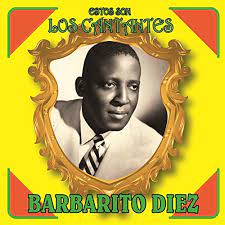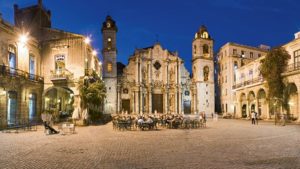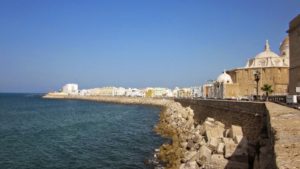BARBARITO DIEZ, AN UNFORGETTABLE CUBAN SINGER KNOWN AS “THE PRINCE OF DANZÓN”. PHOTOS VIDEOS
Barbarito Díez was a Cuban singer who specialized in the original Cuban musical danzón. As the main vocalist of the Antonio Maria Romeu ensemble for 20 years, he established himself as one of the main exponents of the sung danzón.
Barbarito Diez, born in Bolondrón, Matanzas, December 4, 1909, exactly in a sugar mill already demolished called San Rafael de Jorrín, gives birth to Salustiana del Junco y de la Mercedes to Bárbaro Diéz Junco who, with the passing of time became “The Prince of Danzón.”
He did not have academic musical training, he did not play any instrument, but his unique voice and his musical performances made him a public idol, his voice immortalized musical pages such as Martha by the composer Moisés Simmons, Black Tears, Oblivion, Juramento, El Que Siembra Su Maíz by Miguel Matamoros, among others.
ARTISTIC CAREER
From his coincidence with the troubadour Graciano Gómez, Isaac Oviedo, the third wonderful man who went from son to trova, “Los Gracianos” were born. This trio was nourished by the most courageous of our traditions and incorporated genuine roots: Traditional Trova and its range of Habaneras, Boleros, Guarachas, Sones, and Criollas. Usually, they performed at the peña del Café “Vista Alegre” then located in San Lázaro and Belascoain, where Barbarito already showed the elegance that characterized him for more than five decades of artistic life.
From evening to evening and from dance to dance throughout Cuba and Latin America Barbarito walked. Delighted several generations with works by Ernesto Lecuona, Moisés Simmons, Eliceo Grenet, Pedro Flores, Rafael Hernández, and other outstanding composers sheltered by guitars, pianos, and drums, Barbarito displayed his virtuosity and singular charm, the upright, serene demeanor of Palma Real.
In his career of more than 58 years, he recorded a large number of full-length albums that contained works that enrich the Cuban musical repertoire. He traveled to the countries of America, Europe, and the United States, performed programs in Cabaret, Theaters, Dances, Radio, and TV.
Due to his dedication to the development of national art, his fruitful work for the cultural enrichment of our people, medals, orders, and distinctions was imposed on him.
He never learned the theoretical foundations of musical art, but he proved to be one of the most refined and consistent of the Danzón, a genre that as a rhythm remains even in Salsa itself despite having more than 100 years of creation. His unique and unrepeatable voice was heard in Mexico, Venezuela, the Dominican Republic, and Panama, among other stages of the world, achieving throughout his fruitful career the title of: “La Voz de Oro del Danzón”, or “El Príncipe del Danzón ”.
Without intending to, he wove a legend inscribed in good music without borders. The people began to call him ‘La Voz del Danzón’ above all because of his attachment to the genre (Barbarito was a man of fidelity) and perseverance, he always shied away from changing changes so helped by vocalists and groups. That was special with the Danzón.
He counted on the teacher Antonio María Romeu. Who, in addition to introducing the piano in his orchestra to interpret danzones, had a peculiar way of playing that instrument. He was impressed with his unmatched style, technique, and scales. While the voice par excellence of “Tres Lindas Cubanas” and other anthological pages contributed measured and original verve to the dance and singable form recognized as our national dance. That is why it is difficult to mention the Antonio María Romeu Orchestra without adding its singer Barbarito Diez.
Much of the extensive discography that enriches the Cuban musical heritage belongs to him. He was able to expand it in Venezuela where he stood out as one of the most popular interpreters of the ’80s after recording with the string group La Rondalla Venezolana directed by Luis Arismendi.
This distinction is repeated in other places, where the melodious voice that he recreated like no other, Idilio, Ojos Malvados, Along with Palmar del Bajío and La Rosa Roja, enlivens the party among friends.
The presence is not surprising, and much less than Alfredo Sadel and Simón Díaz, Venezuelan musician’s friends of Cuba, defined him as one of the great voices of Latin America. “He delivered in each performance above all the formal achievements (merits and rhythms of him) an authentic atmosphere, blood of his life,” said Díaz.
This projection transcended other genres. In the Cha Cha Chá, he recognized Barbarito “a magnificent form of Danzón that he has ignited in the heart of the Cuban. I accept it as something ours as well as the Danzón. Both branches taste like they are Cuban ”
In Havana, where he died on May 6, 1995, he would be 86 years old. Already then he had the distinctions “For the National Culture” and “Raúl Gómez García”, in addition to the “Alejo Carpentier” medal and the “Félix Varela First Degree Order”, among many awards, recognitions, and trophies.
Whole life for the firm quality of him connected with the best of our musical tradition. Barbarito Diez Junco will always be among us, like a giant on the pentagram of his majestic figure, which, like Palma Real, stands in the Center of National Culture and in the heart of our town that permanently pays Tribute to him.
BARBARITO DIEZ, CANTANTE CUBANO INOLVIDABLE CONOCIDO COMO “EL PRINCIPE DEL DANZÓN”. FOTOS/VIDEOS
Barbarito Díez fue un cantante cubano especializado en la original musical cubana del danzón. Como vocalista principal del conjunto de Antonio Maria Romeu durante 20 años, consagrandose como uno de los principales exponentes del danzón cantado.
Barbarito Diez, nacido en Bolondrón, Matanzas, 4 de Diciembre de 1909, exactamente en un central azucarero ya demolido que se llamó San Rafael de Jorrín, da a luz Salustiana del Junco y de la Mercedes a Bárbaro Diéz Junco quien, con el decursar del tiempo se convirtiera en “El Príncipe del Danzón”.
No tuvo una formación musical académica, no tocaba ningún instrumento, pero su inigualable voz y sus interpretaciones musicales lo convirtieron en ídolo público, su voz inmortalizó páginas musicales como Martha del compositor Moisés Simmons, Lágrimas Negras, Olvido, Juramento, El que Siembra su Maíz de Miguel Matamoros, entre otros.
CARRERA ARTISTICA
De su coincidencia con el trovador Graciano Gómez, Isaac Oviedo tercero maravilloso que iba del son a la trova, nacieron “Los Gracianos” este trío se nutrió de lo más valeroso de nuestras tradiciones e incorporó genuinas raíces: La trova Tradicional y su gama de Habaneras, Boleros, Guarachas, Sones, y Criollas. Por lo general actuaban en la peña del Café “Vista Alegre” entonces ubicado en San Lázaro y Belascoain, donde ya Barbarito mostraba la elegancia que lo caracterizó durante más de cinco decenios de vida artística.
De velada en velada y de baile en baile por toda cuba y Latinoamérica anduvo Barbarito. Deleitó a varias generaciones con obras de Ernesto Lecuona, Moisés Simmons, Eliceo Grenet, Pedro Flores, Rafael Hernández y otros destacados compositores al abrigo de guitarras, pianos y tambores, Barbarito desplegó su virtuosismo y encanto singular, porte erguido, sereno de Palma Real.
En su carrera de más de 58 años grabó gran número de discos de larga duración que contenían obras que enriquecen el repertorio musical cubano. Viajó a los países de América, Europa y E.E.U.U., realizó programas en Cabaret, Teatros, Bailes, la Radio y la TV.
Por su dedicación al desarrollo del arte nacional, su fecunda labor en aras del enriquecimiento cultural de nuestro pueblo le fueron impuestos medallas, ordenes y distinciones.
Jamás aprendió los fundamentos teóricos del arte musical, pero demostró ser uno de los más afinados y consecuentes del Danzón, un género que como ritmo permanece hasta en la misma Salsa a pesar de contar con más de 100 años de creado. Su voz única e irrepetible se escuchó en México, Venezuela, República Dominicana y Panamá entre otros escenarios del mundo logrando a lo largo de su fructífera carrera, el título de: “La Voz de Oro del Danzón”, o “El Príncipe del Danzón”.
Sin proponérselo tejía una leyenda inscrita en la buena música sin límites de fronteras. El pueblo comenzó a llamarlo ‘La Voz del Danzón’ sobre todo por su apego al género (Barbarito era hombre de fidelidad) y constancia, siempre rehuyó el cambia cambia tan socorrido por los vocalistas y agrupaciones. Así fue de especial con el Danzón.
Contó con el maestro Antonio María Romeu. Quién además de introducir el piano en su orquesta para interpretar danzones, tenia un modo peculiar de tocar ese instrumento. Impresionaba con su estilo, técnica y escalas inigualables. En tanto que la voz por excelencia de “Tres Lindas Cubanas” y de otras páginas antológicas aportó bríos mesurados y originales a la forma danzaria y cantable reconocida como nuestro baile nacional. Por eso resulta difícil mencionar a la Orquesta de Antonio María Romeu sin añadir, a su cantante Barbarito Diez.
Buena parte de la amplia discografía que enriquece el acerbo musical cubano le pertenece. Pudo ampliarla en Venezuela donde descolló como uno de los interpretes más populares de la década del 80 tras grabar con la agrupación de cuerdas La Rondalla Venezolana que dirige Luis Arismendi.
Esta distinción se repite en otros lugares, donde la voz melodiosa que recreó como ninguna otra, Idilio, Ojos Malvados, Junto al Palmar del Bajío y La Rosa Roja, ameniza la fiesta entre amigos.
No asombra que Alfredo Sadel y Simón Díaz, músicos Venezolanos amigos de Cuba, lo definieran como una de las grandes voces de América Latina. “Entregaba en cada interpretación por encima de todos sus logros formales (méritos y rítmicos) una atmósfera auténtica, sangre de su vida”, comentó Díaz.
Esta proyección trascendió a otros géneros. En el Cha Cha Chá reconoció Barbarito “una magnifica modalidad del Danzón que ha prendido en el corazón del cubano. lo acepto como algo nuestro al igual que al Danzón. Ambas ramificaciones saben a son cubano”.
En la Habana donde murió un 6 de Mayo de 1995 cumpliría 86 años. Ya entonces contaba con las distinciones “Por la Cultura Nacional” y “Raúl Gómez García”, además de la medalla “Alejo Carpentier” y la “Orden Félix Varela de Primer Grado”, entre muchos galardones, reconocimientos y trofeos.
Toda una vida por su firme calidad entroncó con lo mejor de nuestra tradición musical. Barbarito Diez Junco siempre estará entre nosotros, como un gigante del pentagrama de su majestuosa figura, que cual Palma Real se yergue en el Centro de la Cultura Nacional y en el corazón de nuestro pueblo que permanentemente le rinde Homenaje.
Agencies/ Wiki/ ManatiDistrict/ Internet Photos/ YouTube/ Arnoldo Varona/ www.TheCubanHistory.com
THE CUBAN HISTORY, HOLLYWOOD.











